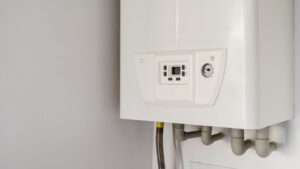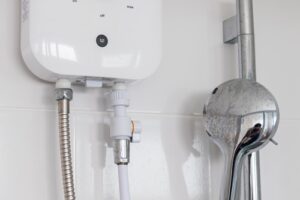There are many appliances that are working behind the scenes and functioning to give homeowners the modern amenities that we all know and benefit from. A lot of times, we only think about these appliances when they are not working, because they are not very noticeable when they are working.
Out of the different appliances that would be found in a residential home, oftentimes the water heater of a home doesn’t get much attention until it breaks and there is no hot water being produced.
Water heaters are responsible for providing hot water to water appliances that need it to function properly. For example, the dishwasher, washing machine for clothes, and the shower all utilize hot water that is made from a water heater inside the home.
Traditional water heaters with tanks can last for many years without experiencing any issues, but at around fifteen years or so they tend to start having issues, and will shortly afterward need to be replaced.
While traditional water heaters have been in use for many years, they are no longer the only option that homeowners can choose from when trying to find a water heating solution for their residence.
Today, another popular option for water heaters are tankless water heaters, which are sometimes called on-demand or instantaneous water heaters.
Both options do very well to supply a home with the right amount of hot water as needed, but the way they work and how they function may appeal to different types of people.
It is important that homeowners become familiar with these differences when they are in need of a new water heater because it can help find the right water heater for their home and their needs.
Here we will be going over some of the major differences between a traditional water heater and a tankless water heater, and how their functionality may differ.
The Heating Mechanism Differences Between Traditional and Tankless Water Heaters
Both traditional water heaters and tankless water heaters work well at heating up water and supplying it to different areas of the home, but they will do it differently.
Traditional Water Heater Heating Mechanism: When talking about traditional water heaters, or tanked water heaters, they will have a holding tank that will store a large quantity of heated water to be used at a moment’s notice within the home.
These tanks will come in different sizes, depending on the needs of the homeowner, or the number of occupants inside the home.
Keep in mind that both electric and gas water heaters will have tanks, but one uses electrical heating elements to heat up the water, while the other will use a burner to maintain a steady water temperature.
Tankless Water Heater Heating Mechanism: Tankless water heaters operate on an on-demand basis. When a hot water tap is turned on, cold water is drawn into the unit through an inlet pipe.
For gas tankless water heaters, a burner is ignited to heat the water as it passes through a heat exchanger. Electric tankless water heaters use an electric heating element for the same purpose.
The results of these two different systems are not too different from one another, but the biggest difference between these two types of water heaters is energy efficiency, and how they are reflected in monthly electric bills.
Energy Efficiency Differences Between Traditional Water Heaters and Tankless Water Heaters
More people are becoming self-conscious about their energy consumption and their energy footprint. This should be a very important issue for a homeowner who is trying to save additional money where they can, such as with their monthly electric bill.
Traditional or tanked water heaters do oftentimes have a larger amount of hot water to be used on demand, however will lead to higher energy costs from the homeowner, as the traditional water is constantly working to maintain that hot water.
The heating element or burner keeps the water in the tank consistently hot, ready for use at any time. However, this continuous heating leads to standby heat loss, where energy is consumed to maintain the water temperature even when not in use.
Tankless water heaters are generally more energy-efficient. They only heat water when there is a demand, eliminating the standby heat loss associated with tanked water heaters. This efficiency can result in energy savings over time.
Tankless water heaters operate on an on-demand basis. When a hot water tap is turned on, cold water is drawn into the unit through an inlet pipe. For gas tankless water heaters, a burner is ignited to heat the water as it passes through a heat exchanger. Electric tankless water heaters use an electric heating element for the same purpose.
Capacity Rates and Recovery Rates Between Traditional and Tankless Water Heaters
Apart from energy consumption and the cost it takes to use these different water heaters, another important difference that homeowners need to be aware of is how well they work with different quantities of water, and how long it takes for that heated water to be recovered for the next time hot water is needed.
While tanked water heaters can supply hot water for multiple fixtures simultaneously, which is not the same when compared to their tankless counterparts, their capacity is limited by the size of the tank. Once the stored hot water is depleted, there is a waiting period for the tank to refill and reheat.
If someone has a tankless water heater, they may find it hard to use more than one water appliance at a time, but this also depends on the quality and features of a tankless water heater. A homeowner may not want to run their dishwasher and shower with a tankless water heater, as it can be hard to heat both due to the on demand features of a tankless water heater. Be this as it may, if someone is using only one appliance at a time, they will find that there is no recovery rate for the use of hot water.
The recovery rate is a crucial factor for tanked water heaters. It refers to the time it takes for the system to heat up a new supply of water after the existing hot water is used. Recovery time depends on the power of the heating element or burner and the size of the tank. Keep in mind also that as traditional water heaters age, they may not be as efficient as they once were regarding how long it takes to heat up water for their next use.
Maintenance Requirements for Tankless and Traditional Water Heaters
If a homeowner wants to get the most use out of their home’s water heater for as long as possible, they should periodically consider getting their unit serviced. Maintenance on most complex machines and appliances is necessary to keep them in working order and top performance.
While these two types of water heaters work and function differently, they have relatively similar aspects when it comes to maintaining them for them to work their best overtime.
Tankless Water Heater Maintenance:
- Descaling:
-
-
- Issue: Over time, mineral deposits (scale) can accumulate on the heat exchanger, affecting performance.
- Maintenance: Periodic descaling is recommended, using a descaling solution, to remove scale buildup. The frequency depends on water hardness.
-
- Flushing:
-
-
- Issue: Sediment and debris may accumulate in the water lines and the unit.
- Maintenance: Flushing the system helps remove sediment and ensures optimal performance. The frequency varies based on water quality.
-
- Air Vent and Exhaust Inspection:
-
-
- Issue: Air vents and exhaust passages may become blocked.
- Maintenance: Regularly inspect and clean air vents and exhaust passages to prevent blockages, particularly in gas-powered units.
-
- Check for Gas Leaks:
-
-
- Issue: Gas-powered tankless water heaters may develop leaks.
- Maintenance: Regularly check for gas leaks and ensure proper ventilation for safety.
-
- Professional Check-Up:
-
- Maintenance: Schedule periodic professional inspections to ensure all components are functioning correctly. This is especially important for gas models.
Tanked Water Heater Maintenance:
- Flushing:
-
-
- Issue: Sediment buildup in the tank can reduce efficiency.
- Maintenance: Flushing the tank periodically removes sediment. The frequency depends on water hardness and the tank’s condition.
-
- Anode Rod Replacement:
-
-
- Issue: Anode rods corrode over time, protecting the tank from rust.
- Maintenance: Replace the anode rod if it’s significantly corroded to extend the tank’s lifespan.
-
- Tank Inspection:
-
-
- Issue: Tanks can corrode or develop leaks.
- Maintenance: Regularly inspect the tank for signs of corrosion, rust, or leaks. Address any issues promptly.
-
- Pressure Relief Valve Check:
-
-
- Issue: The pressure relief valve may malfunction.
- Maintenance: Test the pressure relief valve periodically to ensure it operates correctly and replace it if necessary.
-
- Professional Check-Up:
-
- Maintenance: Schedule professional inspections to check for issues such as gas leaks (for gas models), thermostat calibration, and overall system health.

